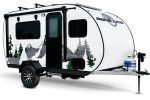Climate Control
Four Season RV-ing
What makes a 4-Seasons RV ready for challenges of weather conditions, from hot and humid summers to arctic winters, how to protect from condensation….
The first part of the series “All-Weather RVs” was dedicated to RVs construction including requirements, preferred materials as well as notes and tips helping to choose the right model for comfortable four-season RV-ing (see --> 4-Season RV Construction Basics).
Now, continuing the series of Four-Season RV-ing we will discuss the basics of RV climate control as well as necessary features protecting plumbing (pipes and holding tanks) from freezing and limiting condensation of moisture.
One of the biggest challenges of four-season RV-ing is maintaining appropriate interior temperature and humidity in extreme weather conditions (hot summer and “icy” winter). The most important challenges are:
Limited access to energy
The main concept of RV-ing is the mobility giving chance to explore the “Whole World” (whatever it means). For most of “city-dwellers” the preference will go to enclaves of unspoiled Mother Nature. In other words: campgrounds, rustic campsites and eventually some sort of “out-of-civilization” wilderness (“off-grid” camping).
Limited Size
An RV unlike a stationary house has much smaller size compared to a typical house. As the result, it’s “Thermal Inertia” (ability to keep interior’s climate) is significantly lower. Changes of exterior weather conditions will quickly impact interior’s “micro-climate”;
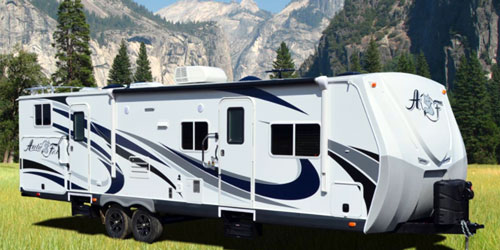
Northwood Four Seasons Arctic Fox travel trailer: Model 31D
Hermeticity
Modern RVs are much more “hermetic” than a typical house. The good outcome (lower energy bills) comes together with “unwanted” characteristics, especially important due to very limited living space.
Hermeticity (think about layers of “impermeable” fiberglass and lamination) prevents natural “breathing” process. As the result – the water condensation causes problems not seen in typical houses. And if this is not enough - you also need well controlled ventilation system to expel “used” air and bring inside the fresh one (typically not the problem in “porous” stationary house/apartment);
Vulnerability of RV’s “water infrastructure”
Unlike house plumbing (mostly installed in interior walls and basement) RV’s plumbing is housed in the shell and underbelly. As the result, it is much more exposed to exterior temperatures with potentially “brutal” consequences.
Below we will try to discuss how these challenges are addressed by manufacturers of modern all-weather RVs.
RV Cooling Systems
Obviously, these days it is difficult to even think about enjoying RV-ing without ability to bring RV’s interior temperature and humidity levels to our “zone of comfort”. But if we put aside our comfort (or lack of it) one thing is sure – the worst what may happen in summer is that from our RV’s faucet will run more or less warm water (probably not bad thing when taking shower or washing dishes). It is in clear contrast with winter when there is real danger of water freezing. The worst what may happen is that nothing will run from the faucet not only because of frozen pipes but also because water will leak into RV’s structure from the broken pipes!
Here is what you should look for when buying an all-weather RV:
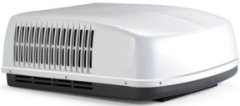
Dual mode (A/C and Heat Pump) roof mounted unit
Energy efficient A/C units
Extreme weather requires extreme means. This includes not only “per-se” efficiency (in terms of “pumping out” the heat). It also means low profile if roof mounted (low aerodynamic drag so higher fuel efficiency when on the road), and “lite” design (less pounds to tow).
Noiseless operation
Let’s face it – what is the difference between the sleepless night due to high interior temperature and the sleepless night due to disturbing noise? It’s the same nightmare (to say it politely)
Cooling margin
It’s the ability to quickly cool down RV’s interior (in other words “extra BTU’s” above what may be needed just to maintain comfortable interior temperature).
Dual-mode units
While modern A/C units run only on electricity, heating may be based on electricity or on burning the propane gas. It turns out that in chilly temperatures (but still above the freezing point) it may be more energy efficient (and less expensive) to use the A/C working in heat-pump mode (if such hardware is installed). While this is not viable option for all-season RV-in in cold climate zones, in many areas across the US it can be practical, elegant and less expensive option.
The detailed presentation of RV A/C systems you will find at:
RV Heating Systems
For many four-season RV-ers enjoying sub-tropical and moderate climate zones the heating is not the major concern. Indeed, if temperatures do not go down below the water freezing point, the only “inconvenience” is the lack of comfort in chilly weather conditions.
Fortunately, for subtropical and moderate climate zones there are many inexpensive heating solutions of which the most popular are:
- Heat Strip (add-on to the traditional AC systems)
- Heat Pump (integral part of modern AC systems)
- Conventional LPG Forced-air Heater (often RV’s standard feature)
- Portable Electric Heaters
- Portable Propane Heaters (warning – you need good ventilation system to provide oxygen as well as to evacuate humidity)
See details at: --> RV Heating Systems
Here we will just emphasize the most important issues related to all-weather RVs heating systems.
The propane-based heating systems
Typically, all-weather RVs are factory equipped with propane furnaces (look for at least 35k BTUs if not more). Gas (LPG) offers at least some limited out-of-grid autonomy but unfortunately most RV furnaces have low energy efficiency. In contrast, electric heating systems have high efficiency, but they require grid because neither batteries nor solar power can supply enough of energy (unless you take on your trip the whole Solar Farm).
Ducted heat distribution systems
Ducted heat distribution at the floor level spreads warm air exactly where it is needed including the underbelly and some storage compartments. Due to the convection process, the hot air will drift towards the ceiling, but there will be no “significant” temperature gradient between the floor level and the upper part of the RV. This is not the case when the heater is installed in the roof (like Heat Strips or Thermo-Pumps which are parts of A/C systems).
The bottom line is - the well-designed ducting system can guarantee an even temperature throughout the RV or (if needed) controlled-temperature zones along the RV (for example lower temperature in the bedroom zone, higher in the living room and bath etc…). It saves energy without jeopardizing the comfort.
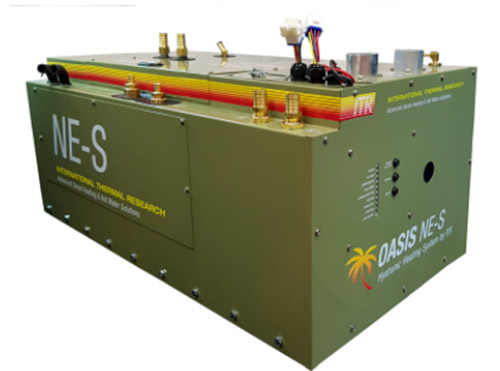
Oasis hydronic heating system
Hydronic heating systems
They are the most complex but also the most efficient and “flexible” RV heating systems especially beneficial for all-weather, year-long RV-ing. No wonder, they are also most expensive systems usually reserved for luxurious models. Typically, they are dual-energy units (either electricity and propane or electricity and diesel). In motorhomes, they can be also connected to the engine cooling system working both ways (heating interior when on the road, and pre-heating engine to avoid cold-start). The most sophisticated hydronic systems use floor-heating for the best comfort.
Read details at: --> RV Hydronic Heating Systems
Humidity Control
RV ventilation is necessary to exchange interior air (in other words provide fresh one and remove “extra” humidity) as well as get rid of odors (if any). While in moderate climate zones you can bring-in fresh air just by opening windows (hopefully screened), humidity and odors need more than just the natural ventilation. Unfortunately, the task is definitely more difficult (and consequences serious) in all-weather RVs during the winter season.
The main sources of vapor in RVs are kitchen (boiling water, propane burners….), bath (shower), breathing and perspiration, wet clothes, catalytic propane heaters (if used) etc …. Just to give you an idea about the gravity of situation – the family of four (2+2kids) can create few gallons of moisture per day!
The moisture contained in the air in contact with “colder” surfaces will condensate. “Foggy” windows will be a minor problem (we can quickly wipe them up), the biggest problem are droplets of water forming on interior walls. They will eventually run down the walls, using every opportunity to infiltrate RV’s structure and/or furniture with potentially disastrous consequences (rot, mold, rust to name only few).
Please note that humidity causes also problems in hot seasons although they are more “limited in space” and less visible. First of all, condensation is mostly “localized” on A/C exchanger (from where it is evacuated outside). Moisture has also tendency to condensate in air distribution systems so some all-weather RVs are equipped with condensation-resistant A/C ducts. I’m not mentioning here the obvious facts: discomfort of RV-ers, but that’s another story.
Assuming indoor temperature about 70 degF (21 degC ), it is suggested to keep RV’s interior relative humidity level in the range as shown below:
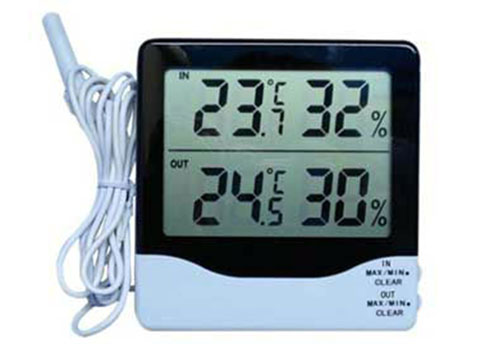
Digital hydrometer
|
Outdoor temperature degF (degC) 20 to 40 F ( -6 to +5 C ) 10 to 20 F (-12 to -6 C ) 0 to 10 F (- 18 to -12 C ) -10 to 0 F ( -23 to -18 C ) -20 to -10 F (-29 to -23 C) Below -20 F ( -29 C) |
Indoor Relative humidity [%] < 40 < 35 < 30 < 25 < 20 < 15 |
Please note that Hydrometer should be part of all-weather RV control and monitoring system (fortunately they are readily available on the market and inexpensive).

RV Dehumidifier: Ivation model IVADM10
Source: goodairgeeks.com
Electric Dehumidifiers
They are efficient, can quickly remove moisture from the air and do not affect the air temperature. The only inconvenience - they need electrical energy to run! (Note that the noise can be annoying especially in compressor-based units so carefully select the model).
Moisture absorbers
The best one is based on Calcium-Chloride (for example Damp-Rid). It has strong moisture absorbing property and it is quite effective. Another moisture absorber - Silica Gel (sodium silicate) is not recommended for RVs as it is poisonous, its absorbing properties are highly dependent on the temperature and is not effective in larger areas. The bad news – all chemical moisture absorbers have to be periodically replaced! Note that even small 12V fan circulating air above the container with moisture absorber will speed-up the whole process.
Ventilation
Fully vented attic system greatly helps to prevent (or minimize) condensation. The warmer air drifts towards the ceiling where the moisture will condensate in contact with colder RV structure.
Tips for reducing condensation
While in hot, humid summers the only rescue from humid heat is good A/C system (plus grid or generator), in cold winters options are more limited and consequences more serious (for RV). That’s why it is important to limit our contribution to the problem by following few simple rules:
- Keep all pots, pans and kettle covered with lids when cooking to prevent steam from escaping, do not cook and boil water longer than needed;
- Use exhaust fan(s) (hood with exhaust fan above the stove will greatly help to contain and then evacuate the steam);
- Keep shower cabin closed, shower water at comfortable temperature (rather than hot), shower time at minimum to limit the amount of moisture released into air. Keep vent fan running when shower in use. It may be also good idea to wipe-out water from cabin’s walls after finishing shower to prevent its evaporation and spread throughout the living area.
- Do not air dry wet clothes inside of the RV, for that purpose use dedicated campground facilities or exposure to sun and wind (if possible)
- Keep RV ventilated (in winter is a compromise between warmness (comfort and cost) and condensation (damp, mildew, etc…)
- Do not underestimate the amount of moisture released by breathing. If possible, keep bedroom’s window (or vent) slightly opened during the night.
- Do not use portable propane heaters (especially catalytic heaters). The byproduct of the propane burning process (and chemical reaction in catalytic heaters) is water. And even more important - they deplete oxygen so you need good ventilation system to be sure you will “wake up alive” the next morning. Summarizing – propane heaters may be good in the patio but for sure not for interior, especially if interior is so small and quite hermetic!
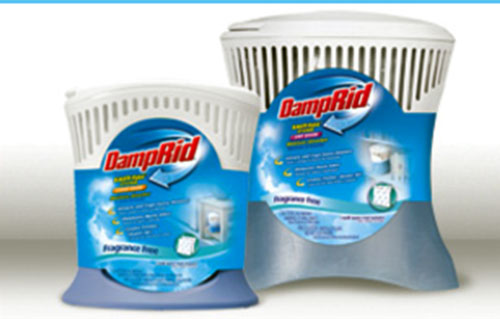
Example of DampRid Moisture Absorbers
Source: damprid.com
Note: Having carpeted floors may be nice when getting up from the bed, but in a humid environment the carpet makes “great” substrate for growing mold (especially around the walls). The message is clear: all-weather (four-season) RVs should Not have carpeted floors as they accumulate damp and water running down the walls!
Odors
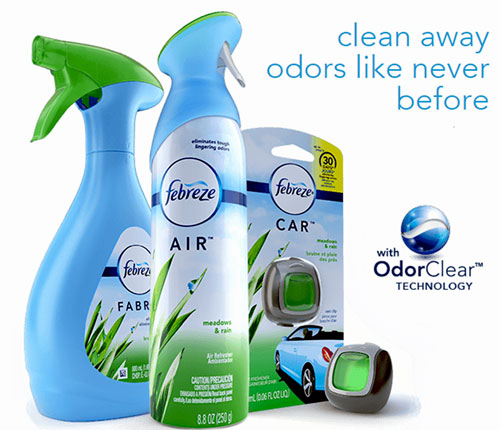
Febreze odor eliminators
They are not always easy to eliminate/evacuate and sometimes very disturbing. Keep in mind that the RV living area is quite small so even slight amount of odor will quickly fill the space and make an unpleasant effect. It’s already difficult to control the “quality of air” in normal circumstances, but all-weather RVs make it even worse!
Obviously when cooking, try to use the exhaust vent (make sure that the filter is clean and functional). Cigarettes smoke can be impossible to eliminate so try to find a “smoking room” outside (easy to do when weather is nice). Similarly, pet’s odor is difficult to eliminate but at least in this case it is more about “love” for our 4-legged friends than an addiction to nicotine. Please note that traditional air-fresheners do not eliminate odors, they just minimize their perception (mask them) by spreading their own stronger and hopefully pleasant scent.
In contrast, the odor killers (like family of Febreze odor eliminators) have ability to “neutralize” smelly molecules by trapping them inside their own molecular “structures” and limiting their volatility.
The most distasteful case is the odor from grey and black tanks. Both of them have vent pipes ending at the RV roof. They work well when RV’s interior pressure is the same as the exterior one (so when windows, doors or skylights are open). In all-weather RVs and cold winter conditions the interior is quite well “sealed” from the outside to prevent heat losses so the air pressures may not be at equilibrium. In such case if the interior air pressure is lower, the tanks odor may “leak” through toilet(s) and water-pipes syphons. Similar situation may be created by strong wind (typical at high-speed towing).
Water Freezing Protection
Most of the water pipes as well as holding tanks, dump pipes and valves are housed in RV’s basement (underbelly). However, unlike residential houses’ basements, all-weather RV’s underbelly is very much exposed to cold temperatures and icy wind. To prevent water freezing it is not enough to have an enclosed underbelly. It also must have an efficient heating system that being capable to keep temperature of critical components above the water freezing level.
1. Ducted Heating System
Forced-air heating system is a must in all-weather RVs. With long term exposure to temperatures well below freezing point traditional electrical heating pads are not sufficient to keep water installation safe.
For better and more efficient protection, some water elements (holding tanks, dumping valves …) should be “suspended” to facilitate warm air circulation around.
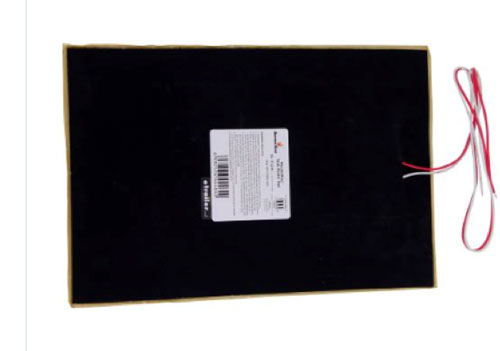
Example of a 12V Holding Tank Heating Pad
(Model CP-TH1812)
2. Electrical Heating Pads.
As mentioned above, ducted forced-air heating system in the underbelly is necessary in all-weather RVs. However, in some circumstances (for example when towing), the main heating system may be turned off for security reasons. That is why the secondary heating system capable to maintain the temperature of critical components above the freezing point is also required. And here is the room for all kinds of heating pads, heating mats etc…
Please note that when on the road, you have no access to the grid, so the secondary heating system must run on batteries (12V). Some claim that it will deplete the auxiliary batteries, but let’s face it – you have little choice (unless you drive a motorhome and can use an engine cooling system for heating).
While 120Vac heating pads are readily available and can be used when hooked to the grid, running them through inverter when on the road will only accelerate battery discharge. This is due to inverter’s limited efficiency (in practical words, some energy will be lost in the conversion process). Purists may say that the energy cannot be lost, and this is true, however it is also truth that it will be difficult (if not impossible) to re-use the energy dissipated in the inverter to heat the underbelly.
The good news is that most electrical heating elements include thermostats. They are set to keep “reasonably-safe” temperatures of critical elements and will automatically turn off when the heating is not necessary. This feature hopefully can guarantee batteries autonomy when on the road.
Typically, all -weather RVs are factory equipped with the primary and secondary underbelly heating systems so you have little choices in terms of 12V or 120V heating elements (unless you can make selection).
3. Individual Thermal Insulation
To farther extent the energy autonomy for longer run, the water system components (pipes, tanks…) must have individual thermal insulation installed over the heating elements. These will be traditional foam pipes, insulating fiberglass mats for holding tanks etc..
4. Underbelly Insulation
The RV’s underbelly must have its own layers of thermal insulation to prevent heat losses (increase heating efficiency, lower the bills). Typically, underbelly’s insulation makes part of the floor insulation barrier. And as we all know very well – cold floor is also a huge factor in our perception of comfort.
Read more on RV thermal insulation at:
--> Basics of All-weather RV Construction
5. Skirting
Skirts themselves do not have any meaningful R-value (in a classic sense). However, they can enormously help to minimize the impact of icy winds. We all know that our perception of “temperature” highly depends on a wind factor. Simply speaking let’s say 0 degF may feel like minus 20 degF when we are exposed to the wind. And this is not only a subjective feeling, the truth is that wind accelerates the transfer of heat and so increases heat losses. And that is where comes skirting. When properly installed, skirts protect RV’s underbelly from the gusts of wind and in this sense, they have some “relative” R-value adding to the overall thermal insulation barrier.
Full-time living may also convince some RV-ers to add foam-blocks behind the skirting. It will definitely help to decrease energy bills but is not practical for those enjoying “mobility”. They take too much of storage space to carry them “around the country”
Notes:
Utility center
The exterior compartment housing utility center (all water hook-ups including exterior shower, water pump etc…) must be well insulated (especially door) and in most cases heated.
Fresh/City Water hook-up
You can buy electrically heated hose (120V ac) to keep your RV connected to the city water distribution system. But in many cases, it may be impractical (if not dangerous). Most city water hook-ups are housed in protected Utility Compartments so permanently installed water supply hose will expose part of the water system to outdoor temperatures. In other words, what is practical in warm climate zones will not work in northern winter zones.
It is rather suggested to fill the fresh water tank when needed, disconnect the supply hose and drain-it out from the water before storing.
Holding tanks
It is a good idea to empty grey and black water tanks before the next leg of your trip. As a low cost extra protection effort, you may add a bit of RV antifreeze to mentioned tanks. The goal is to fill dumping valves with antifreeze protecting them this way from freezing. BTW – just to know: the knife-valves perform better in cold weather environment as they utilize blade to cut through the “heavy liquids”.
Stabilizing Jacks
These are kind of “set-and-forget” components of your RV. However, it may be no so, when metals pads will freeze to pavement of concrete (according to Murphy’s Laws – “If something can happen, it certainly will”. When planning winter trips it is suggested to carry wooden blocks so they can be placed under the jacks’ pads. It will make much easier to fold the jacks and then eventually to hammer out from the ice the wood blocks (or just leave them and replace by spare ones on your next camping site).
Refrigerator
Refrigerant (whatever it is – ammonia, hydrogen gas, etc) in extreme weather conditions (below -20F) may turn to the gel and plug heat exchanger coils usually exposed to the outdoor temperature. DIY solution is to close some of the exterior vent slots by covering them with the duct tape (or any layer of insulation).
You may have to remember however to re-open the blocked vent slots once you move your RV to a warmer area.
Engine Block Heater
With the exception of motorhomes, successful starting of the cold engine at “arctic” temperatures is not the RV problem, but rather towing car problem. However, recognizing its importance we strongly suggest installing engine block heater when you plan winter RV-ing in northern states. It’s true that you will need the grid to run it (not always available), but at least whenever possible it will save you a lot of frustrations.
Winter Packages
For four-season RV-ers industry offers so called Winter Packages either as selectable or mandatory option. Let’s list few most popular packages: Keystone “Four Season Living Package”, Hartland’s “Yeti Extreme Weather Package”, Northwood “Arctic Fox” (not really package, but rather four-season “all-inclusive” offer) etc….
They all provide pretty much the same features like enclosed, heated underbelly, extra R-values for thermal insulation, water system heating pads (either 12Vdc or 120V ac), some include dual-pane windows etc. However, you have to carefully look at the details and make sure that the package meets your requirements. Simply speaking each package represents manufacturer’s view on what is necessary for winter and what not. Although at first look the winter package features look similar, you may find big differences in R-values of thermal insulation throughout all-weather RVs. Please note that it may be difficult (if not impossible), risky and certainly costly to install extra DIY -type of thermal protection. The right time for that is when you negotiate your requirements with the factory before signing the buying contract.
Rain Protection
The rain is part of the life and so part of four-season RV-ing so there is not much you can do about it. What you can do however is to make sure that your RV (especially all-weather one) has drip rails and down spouts. It’s not that it will protect you from the rain, but definitely it will protect RV’s walls from getting unwanted colors…
.


